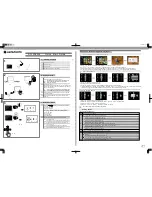
66
B
asic
O
p
er
at
ions
3
“Red-eye” is the phenomenon where eyes look reddish in photographs
taken in dark environments with a flash. This is caused by the reflection of
the electronic flash in the retina of the eye. Red-eye occurs because pupils
are dilated in dark environments.
This phenomenon cannot be averted but the following measures can be
used to combat it.
• Brighten the surroundings when shooting.
• Set to wide angle and move closer to the subject if a zoom lens is in use.
• Use a flash that supports red-eye reduction.
• Position the flash as far away from the camera as possible when using
an external flash.
The red-eye reduction function on this camera reduces red-eye by discharging
the flash twice. With the red-eye reduction function, the pre-flash is discharged
just before the shutter is released. This reduces pupil dilation. The main flash
is then discharged while the pupils are smaller, reducing the red-eye effect.
To use the red-eye reduction function in Picture mode or
H
mode, select
D
(Auto flash+Redeye reduct) or
F
(Flash On+Red-eye). Set to
F
(Flash
On+Red-eye) in other modes.
In daylight conditions, the flash will eliminate shadows when a portrait
picture is taken with a person’s face cast in shadow. Use of the flash in this
way is called Daylight-Sync Shooting. Flash On is used when shooting
with Daylight-Sync Shooting.
Taking pictures (Auto Picture mode)
1 Pop up the flash manually and confirm that the flash mode is set to
E
(Flash On). (p.65)
2 Confirm that the flash is fully charged.
3 Take the picture.
Using Red-eye Reduction Flash
Daylight-Sync Shooting
The picture may be overexposed if the background is too bright.
Without Daylight-Sync
With Daylight-Sync
Summary of Contents for 19541
Page 36: ...Memo 34 ...
Page 56: ...Memo 54 ...
Page 182: ...Memo 180 ...
Page 202: ...Memo 200 ...
Page 220: ...Memo 218 ...
Page 224: ...Memo 222 ...
Page 267: ...Memo ...
















































